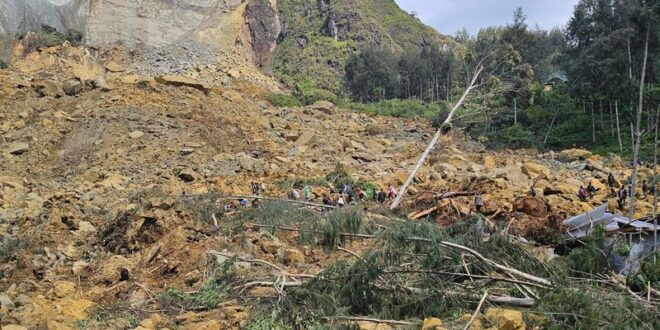SYDNEY (Reuters) – Families in Yambali village in Papua New Guinea were sleeping peacefully in their beds when a “mountain” of rubble buried them alive in a gigantic landslide, said a U.N. rescue worker at the disaster site and the country’s prime minister.
For five days now those that survived have been using shovels and bare hands to dig through mud and debris almost two storeys high, and covering three to four football fields in area, which has buried an estimated 2,000 people.
Rescue officials say chances of finding survivors are slim.
“It’s basically a mountain that has fallen on their heads,” said Mate Bagossy, who is with the United Nations Development Programme helping relief efforts in remote Yambali in the northern Enga Province.
Estimates of the death toll have varied vastly with the government saying more than 2,000 were buried alive, while the UN estimates about 670 are missing. Community leaders have put the figure at around 200. Only six bodies have been recovered.
“Our people in that village went to sleep for the last time, not knowing they would breathe their last breath as they were sleeping peacefully,” Papua New Guinea Prime Minister James Marape told parliament on Wednesday.
“Nature threw a disastrous landslip, submerged or covered the village,” Marape said.
The prime minister blamed “extraordinary rainfall” and changes to weather patterns for the landslide and multiple disasters that have hit the Pacific Island nation this year.
Satellite images and pictures from the UN team and local villagers give a sense of the scale of Friday’s landslide.
“It’s an entire village and shops and a fuel station and a lodge and the church and the school … all of that has gone,” said Bagossy, one of the first of few foreign aid workers to arrive at the village earlier this week.
There is at least six to eight metres (20-26 feet) of rubble covering the area, he said, adding the village lodge was partly visible because the landslide only covered a portion.
“But everything else is under the rubble,” he said.
Sadly, Bagossy conceded the chances of finding survivors was nearly zero.
Only one excavator has arrived at the location but is not being used due to concerns that the land is still unstable. Thousands of people have been ordered to evacuate amid further earth slips in the mountain.
Geologists and geo-hazard specialists from Australia and New Zealand are on their way to the village to make an urgent assessment.
“The entire area needs to be surveyed to understand the risk of further landslide in the area and surroundings. It’s very complicated to bring in heavy machinery if the terrain is not stable. The entire road was sinking,” Bagossy said.
The U.N. migration agency has warned of the risk of infectious diseases due to decaying bodies.
“Every passing minute, bodies buried under the debris are decaying, with water squeezed between the ground and the vast debris covering an area of three to four football fields is continuing to leak, this is posing a high health risk,” Serhan Aktoprak, the chief of the agency’s mission in Papua New Guinea said in an emailed statement.
(Reporting by Praveen Menon, Kirsty Needham and Renju Jose; Editing by Michael Perry)
 BeritaKini.biz Berita Viral Terkini di Malaysia
BeritaKini.biz Berita Viral Terkini di Malaysia





